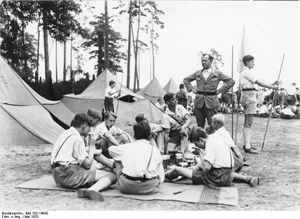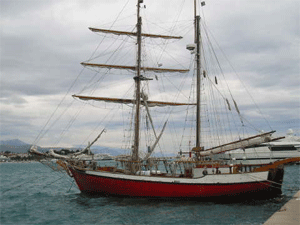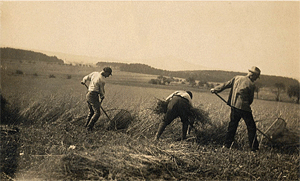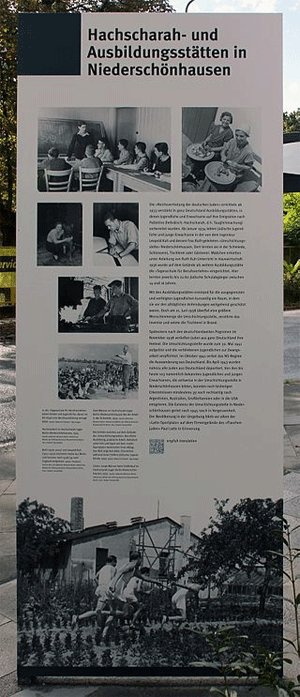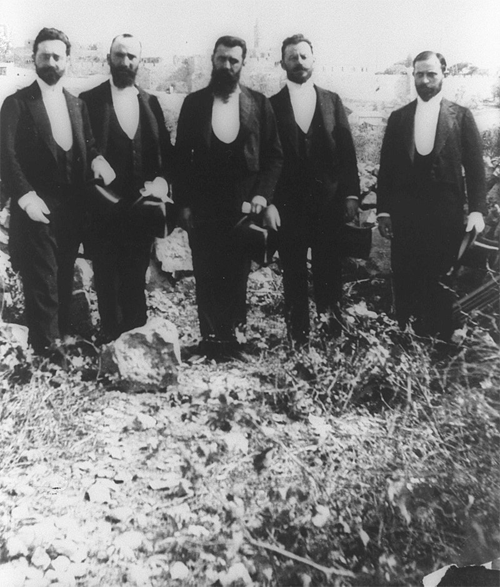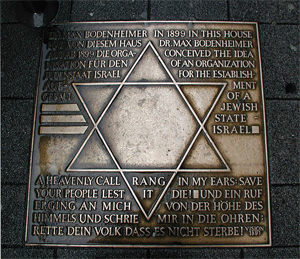by Wikipedia
Accessed: 11/14/18
NOTICE: THIS WORK MAY BE PROTECTED BY COPYRIGHT
YOU ARE REQUIRED TO READ THE COPYRIGHT NOTICE AT THIS LINK BEFORE YOU READ THE FOLLOWING WORK, THAT IS AVAILABLE SOLELY FOR PRIVATE STUDY, SCHOLARSHIP OR RESEARCH PURSUANT TO 17 U.S.C. SECTION 107 AND 108. IN THE EVENT THAT THE LIBRARY DETERMINES THAT UNLAWFUL COPYING OF THIS WORK HAS OCCURRED, THE LIBRARY HAS THE RIGHT TO BLOCK THE I.P. ADDRESS AT WHICH THE UNLAWFUL COPYING APPEARED TO HAVE OCCURRED. THANK YOU FOR RESPECTING THE RIGHTS OF COPYRIGHT OWNERS.
Under the name Jewish youth movement various Jewish youth associations of the German Empire and the Weimar Republic are summarized, which were influenced in their contents and forms of the German youth movement and at the same time relied on specifically Jewish elements. The frets of the Jewish youth movement made in only a short time interval the developments of the German youth movement, first forms of the Wandervogel, later the Bündnis Jugend and the Jungeschaft were adopted.
With the increasing Jewish persecution in the German Reich between 1933 and 1939, the possibilities of the Jewish youth leagues were increasingly restricted until they were banned in 1939. Numerous members of the frets were murdered in extermination camps. A double exception is the Hashomer Hatzair, which emerged as the only significant alliance of the Jewish youth movement outside the German Reich and exists because of its international orientation to this day.
The political alignment of the Jewish frets was uneven and changed over time. At the beginning, the coinage was dominated by assimilated Judaism, while later, above all, Zionist and socialist ideas shaped the frets. In addition, there were always groups of religious Judaism.
History
In its initial phase, the wandering bird movement took boys regardless of their religion. From 1904, the movement split into different frets, some of which, like the Wandervogel, German Bund already made in their name the reference to Germanism. At the same time, ideas of the Dürer League and the All-German Association gained supporters in the Wandervogel movement. [1] In the following years, the Wandervogel movement oriented in many parts increasingly on the nationalist movement. The Austrian Wandervogel declared in 1913: "That is why we (...) have made it known that we have neither slaves nor woods. We still want to see Jews in our ranks, because we, surrounded by strangers and interspersed by half-breeds, must preserve our racial purity." [2]
In the first decade of the 20th century, the first local Jewish hiking groups emerged from this experience of being unwanted in the Wandervogel movement, such as the 1907 Breslauer Wanderverein. In 1912, its founder, Joseph Marcus, encouraged the foundation of Wandervogel-like youth groups on the Delegation Day of the Zionist Association for Germany. In the same year, blue-white bands were created in several places, which merged in 1913 with the hiking club in 1907 to blue-white, Bund for Jewish youth hiking in Germany. By an anti-Semitic incident in a ZittauerWandervogelgruppe, which was picked up by the media in the German Reich, had blue-white already in its founding year strong inflow. [3] When war broke out in 1914 had blue and white 900 members until the end of the First World War the number of members grew to about 3000. [4] Inspired by this successful foundation of the German Empire was an identically hiking Bund in Austria.
Although Blau-Weiß was dissolved in 1925-26 after a failed settlement project in Palestine, its development characterized that of most other Jewish youth fraternities: the emergence in response to external influences, the development of its own youthful style and the move to Palestine and Alija are typical of the Jewish youth movement. [5] From the residual groups of blue-white led to several other Jewish youth associations who underwent similar development steps.
Unlike the non-Jewish youth leagues, the Jewish fraternities were not dissolved after the seizure of power by the National Socialists, but they had to join the Reich Committee of the Jewish youth associations. The work centered more and more on the Hechaluz and the emigration to Palestine, for which the Hessscharah camps were set up, which were also used to train against the National Socialist ideology. In these forms, the frets of the Jewish youth movement could continue to work until 1938, when they were affected by the intensified persecution after the November pogroms of 1938 completely change their work to emigration. In early 1939, the Jewish youth leagues were then banned. Individual groups continued their work until 1943 as part of the Hachsharah camp, although the emigration of Jews from the German Reich had already been prohibited in 1941 and the camps had been converted into forced labor camps. The Hachscharah-Gut Landwerk Neuendorf in Neuendorf in the sand in today's free community Steinhöfel was the last of the camp on 8 April 1943 dissolved, the 160 people were deported to the concentration camp Auschwitz-Birkenau. [6] [7]
One after the factory action on February 27, 1943 underground in Berlin existing group from this area was the Chug Chaluzi to Jizchak Schwersenz. [8th]
Through the Youth Aliyah and Hachsharah, several thousand juvenile Jews were able to emigrate to Palestine. [9] They introduced forms of youth movement into the Israeli youth organizations, such as the Boy Scouts, which continue the Jewish youth movement.
In addition, in the 1930s, there were often overlaps between resistance groups originating from the workers' movement, for example the KPD, the KPO, the IKD and the ISK on the one hand, and Jewish youth organizations such as the Deutsch-Juden Wanderbund "Kameraden", the Werkleute or the Hashomer Hatzair on the other hand [10 ]. The most famous of these resistance groups is the one around Herbert Baum, which formed around 1933 and was smashed after the arson attack on the Nazi propaganda exhibition "The Soviet Paradise" on May 18, 1942.[11]
Frets of the Jewish Youth Movement
Similar to the non-Jewish youth movement, the Jewish youth movement was characterized by a multitude of different frets, some of which existed only briefly, fused together or split off from other frets. The most important frets were:
• Blue and white, Bund for Jewish Youth Hiking in Germany
• Brith Hanoar schel ziere Misrachi (Association of Misrachi Youth)
• League of Jewish Boy Scouts
• Esra Pirche Agudath Jisroel (Ezra, League of the faithful Jews) [12]
• Habonim Noar Chaluzi (builders)
• Hashomer Hatzair (Young Guardians)
• Jung-Jewish Wanderbund, from 1929 Brith Haolim (Bund der Aufsteigenden)
• Kadima, Ring Jewish Wander- und Pfadfinderbünde; Separation: Jewish Scout Federation Germany
• Comrades, German-Jewish Wanderbund, from him several splits emerged:
• Black bunch around Hans Litten and Max Fürst (writer)
• Workmen (Bund Jewish Youth)
• Black flag, from this in turn split in 1934 under the leadership of Paul Yogi Mayer [13] the group
• Blue flock off.
• Free German-Jewish youth
• Maccabee Hazair (Young Maccabees )
• League of German-Jewish Youth (BDJJ). To him in December 1933, the following non-Zionist federations had joined together [14] :
• German-Jewish Youth Community (DJJG)
• Hamburg German-Jewish Youth
• Jewish youth and children's crowds Berlin
• Jewish-liberal youth club
• CV youth groups
See also
• Hans Litten
• Children and Youth Alijah
Literature
• Jutta Hetkamp: The Jewish Youth Movement in Germany from 1913-1933. LIT, Münster 1994. ISBN 3-89473-797-2 .
• Werner Kindt (ed.): Documentation of the youth movement.
• Vol 2: The Wandervogelzeit. Sources for the German Youth Movement 1896-1919. Diedrichs, Dusseldorf 1968.
• Vol. 3: The German Youth Movement 1920 to 1933. The Bündische Zeit. Diedrichs, Dusseldorf 1974, ISBN 3-424-00527-4 .
• Irmgard Klönne: German, Jewish, Bündisch. Memory of the Jewish youth movement expelled from Germany. Pulse 21. Verlag der Jugendbewegung, Witzenhausen 1993, ISSN 0342-3328
• Eliyahu Kutti Salinger: Next year in kibbutz. The Jewish-Chaluzian youth movement in Germany between 1933 and 1943. KoWAG, Paderborn 1998, ISBN 3-933577-01-2 .
• Bodo Mrozek : Short Portraits of Jewish Youth Federations, in: Wilfried Löhken u. Werner Vathke: Jews in the resistance. Three groups between struggle for survival and political action, Berlin 1939-1945 . Berlin 1993, ISBN 3-89468-068-7 .
• Andreas Winnencken: A case of anti-Semitism. On the history and pathogenesis of the German youth movement before the First World War. Science and Politics, Cologne 1991, ISBN 3-8046-8770-9 .
• Lothar Bembenek: Werner T. Angress, Paul Yogi Mayer and Guy Stern. In: Barbara Stambolis (ed.): Youth Movement coined , V & R UniPress, Göttingen, 2013, ISBN 978-3-8471-0004-1 , pp. 69-88.
• Ḥotam, Yotam (ed.): German Jewish youth in the "Age of Youth" , V & R Unipress, Göttingen, 2009, ISBN 978-3-89971-557-6 .
Web links
• House of the Wannsee conference: The black heap ( Memento of 3 May 2006 in the Internet Archive ) - Representation of a emerged from the comrades group
• Hachschara site Ahrensdorf , headed by Maccabi Hazair
• The Blue and White Leaves (old episode) , Blue and White Leaves (new episode) and Blue and White Leaves ("Führerzeitung") of the Federal Government for Jewish Youth Hiking in Germany in the Internet Archive of Jewish Periodicals
• Youth in Germany 1918 to 1945: Jewish Youth (NS Documentation Center of the City of Cologne)
Individual proofs
1. Winnecken. P. 34
2. quoted after Winnecken. P. 39 f.
3. Winnecken. P. 101 ff.
4. Kindt. Vol. 2, p. 728 ff.
5. Salinger. P. 13 ff.
6. Salinger. P. 157.
7. Rosa Luxemburg Foundation : A history of Fürstenwalder (PDF, 38 kB)
8. Wolfgang Benz , Walter H. Pehle (ed.): Encyclopedia of German Resistance. 2nd, durchges. Aufl . Fischer, Frankfurt am Main 1994, pp. 189-190.
9. Salinger. P. 222.
10. Arnold Pauker: German Jews in the Resistance 1933-1945. Facts and problems (2nd edition) . Memorial German Resistance, Berlin 2003, p. 17-18. 21-27 and 31-34, PDF here .
11. Wolfgang Benz / Walter H. Pehle (ed.): Lexicon of the German resistance. 2nd, durchges. Edition . Fischer, Frankfurt am Main 1994, pp. 225-227.
12. Manfred Voigts: Esra. An Orthodox Jewish Youth League 1919-1933 . In more detail: Benjamin Benno Adler: Ezra. The History of an Orthodox-Jewish Youth League at the Time of the Weimar Republic , Harrassowitz, Wiesbaden, 2001, ISBN 978-3-447-04433-2
13. To Black Flag and Blue Flock see: Lothar Bembenek: Werner T. Angress, Paul Yogi Mayer and Guy Stern
14. League of German-Jewish Youth (BDJJ)

